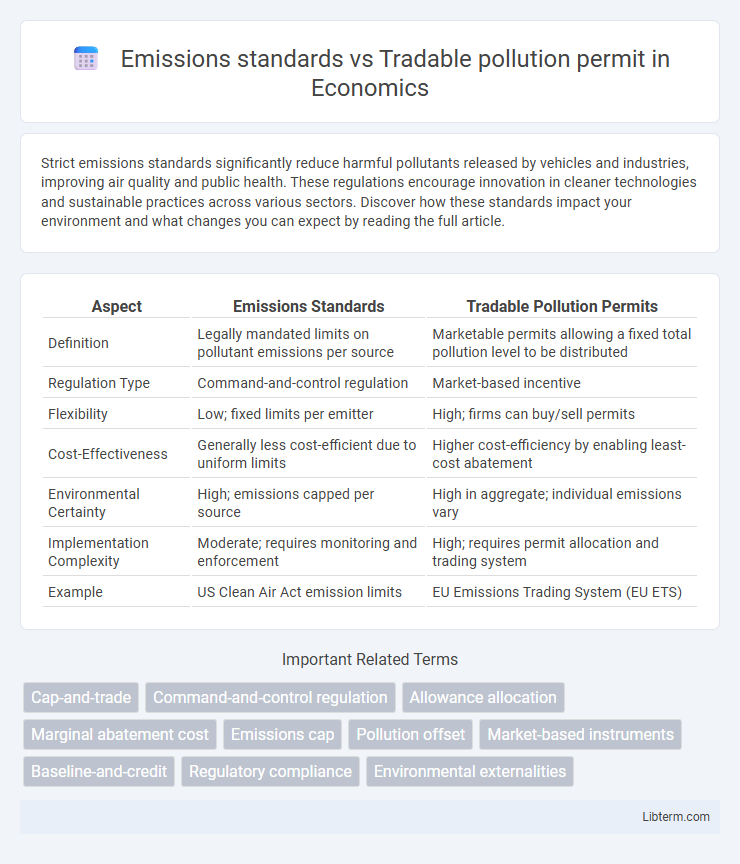Strict emissions standards significantly reduce harmful pollutants released by vehicles and industries, improving air quality and public health. These regulations encourage innovation in cleaner technologies and sustainable practices across various sectors. Discover how these standards impact your environment and what changes you can expect by reading the full article.
Table of Comparison
| Aspect | Emissions Standards | Tradable Pollution Permits |
|---|---|---|
| Definition | Legally mandated limits on pollutant emissions per source | Marketable permits allowing a fixed total pollution level to be distributed |
| Regulation Type | Command-and-control regulation | Market-based incentive |
| Flexibility | Low; fixed limits per emitter | High; firms can buy/sell permits |
| Cost-Effectiveness | Generally less cost-efficient due to uniform limits | Higher cost-efficiency by enabling least-cost abatement |
| Environmental Certainty | High; emissions capped per source | High in aggregate; individual emissions vary |
| Implementation Complexity | Moderate; requires monitoring and enforcement | High; requires permit allocation and trading system |
| Example | US Clean Air Act emission limits | EU Emissions Trading System (EU ETS) |
Introduction to Emissions Standards and Tradable Pollution Permits
Emissions standards set legal limits on the amount of pollutants that can be released from specific sources, ensuring compliance through fixed regulatory thresholds. Tradable pollution permits allocate a total allowable emission cap and enable entities to buy or sell emission allowances, creating economic incentives for pollution reduction. Both approaches aim to control environmental impact, with emissions standards emphasizing direct regulation and tradable permits promoting market-driven solutions.
Defining Emissions Standards
Emissions standards are regulatory limits set by governments that dictate the maximum amount of pollutants a source can emit, ensuring air quality compliance and protecting public health. These standards specify allowable concentrations or total emissions of substances like carbon dioxide, nitrogen oxides, and sulfur dioxide, often tailored to different industries and technologies. Unlike tradable pollution permits, emissions standards impose fixed limits without providing flexibility for trading or market-based adjustments.
Understanding Tradable Pollution Permits
Tradable pollution permits, also known as cap-and-trade systems, create a market-driven approach to limit emissions by setting a total allowable pollution cap and distributing permits that companies can buy or sell. This system incentivizes businesses to reduce emissions cost-effectively, as firms that emit less than their permit can profit by selling excess allowances. Compared to fixed emissions standards, tradable permits offer greater flexibility and economic efficiency while ensuring overall environmental goals are met.
Historical Background and Global Adoption
Emissions standards emerged in the 1970s as a regulatory approach to limit pollutants by setting fixed maximum emission levels for industries, pioneered by the US Clean Air Act of 1970. Tradable pollution permits, also known as cap-and-trade systems, originated in the Acid Rain Program initiated by the US Environmental Protection Agency in 1990, allowing companies to buy and sell emission allowances under a capped total limit. Globally, emissions standards have been widely implemented across Europe, China, and India, while tradable permits have gained traction in the EU Emissions Trading System and regional markets like California's cap-and-trade program.
Mechanisms of Regulation: Command-and-Control vs Market-Based Approaches
Emissions standards employ a command-and-control mechanism by setting fixed limits on pollutant levels that firms must not exceed, ensuring regulatory compliance through mandatory requirements and penalties. In contrast, tradable pollution permits utilize a market-based approach by allocating a cap on total emissions and allowing firms to buy and sell emission allowances, creating financial incentives for pollution reduction. The command-and-control method provides predictability in emissions limits, while market-based permits encourage cost-effective innovation and environmental performance through flexible trading.
Economic Efficiency and Environmental Outcomes
Emissions standards mandate specific limits on pollutants, ensuring predictable environmental outcomes but often lacking cost flexibility, which can reduce economic efficiency. Tradable pollution permits create a market-driven system where companies buy and sell emission allowances, promoting cost-effective pollution reduction by incentivizing the lowest-cost emitters to cut emissions. This market mechanism typically leads to improved economic efficiency and can achieve comparable or superior environmental outcomes compared to rigid emissions standards.
Flexibility and Compliance Costs
Emissions standards impose fixed limits on pollutants, often resulting in higher compliance costs due to rigid requirements and the need for specific technologies. Tradable pollution permits offer greater flexibility by allowing firms to buy and sell emission allowances, enabling cost-effective reductions where marginal abatement costs vary. This market-based approach generally lowers overall compliance costs while promoting innovation in emission control strategies.
Case Studies: Real-World Applications
California's cap-and-trade program demonstrates the effectiveness of tradable pollution permits by significantly reducing greenhouse gas emissions while promoting economic growth. In contrast, the European Union's Emission Trading System (EU ETS) showcases challenges in permit allocation and price volatility but remains a cornerstone for carbon market design. Meanwhile, Japan's strict emissions standards for automobiles have led to substantial improvements in air quality and vehicle efficiency, highlighting the benefits of prescriptive regulatory approaches.
Challenges and Limitations of Both Approaches
Emissions standards often face challenges in enforcement and monitoring, leading to higher compliance costs and limited flexibility for firms to innovate or reduce emissions beyond set limits. Tradable pollution permits can create market volatility and potential loopholes, risking overallocation that undermines emission reduction goals and requires robust regulatory oversight. Both approaches struggle with accurately measuring emissions and addressing equity concerns, as disadvantaged communities may still experience localized pollution hotspots.
Policy Recommendations and Future Directions
Policy recommendations emphasize integrating emissions standards with tradable pollution permits to enhance environmental efficacy and economic efficiency. Future directions suggest expanding market-based instruments to complement strict regulatory limits, encouraging innovation in low-emission technologies. Implementing adaptive frameworks that align permit allocations with real-time emissions data can optimize pollution control and support sustainable development goals.
Emissions standards Infographic

 libterm.com
libterm.com